-
1 of 253523 objects
Twelve historical rulers of Bavaria c. 1842
Gilt bronze, bronze | 69.7 x 23.6 x 23.0 cm (general measurement for all members) | RCIN 21933
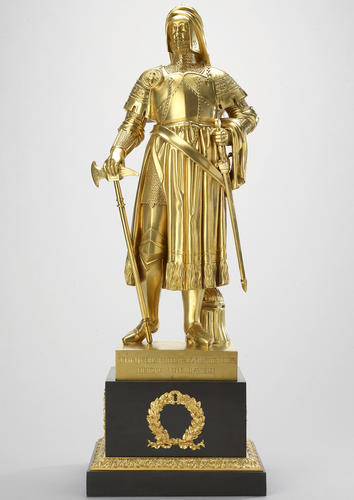
After Ludwig Michael von Schwanthaler (1802-48)
Master: Twelve historical rulers of Bavaria Item: Otto D. Erlauchte Pfalz Graf bey Rhein, Herzog von Bayern c. 1842
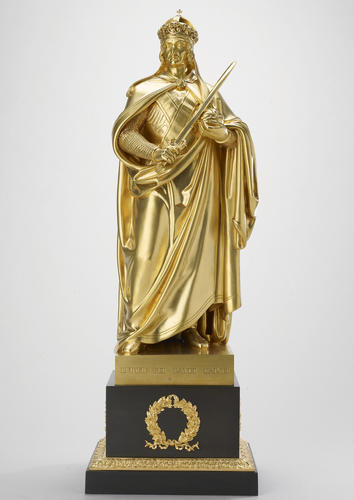
After Ludwig Michael von Schwanthaler (1802-48)
Master: Twelve historical rulers of Bavaria Item: Ludwig der Bayer Kaiser c. 1842

After Ludwig Michael von Schwanthaler (1802-48)
Master: Twelve historical rulers of Bavaria Item: Ruprecht Kaiser / Churfürst von der Pfalz c. 1842
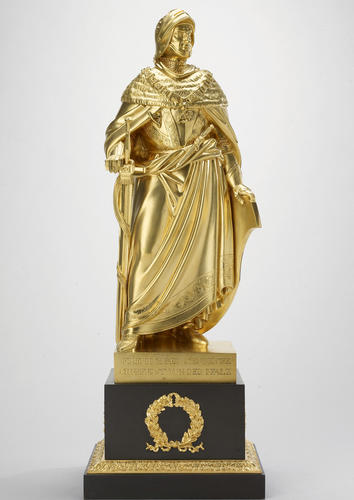
After Ludwig Michael von Schwanthaler (1802-48)
Master: Twelve historical rulers of Bavaria Item: Friedrich der Siegreiche / Churfürst von der Pfalz c. 1842
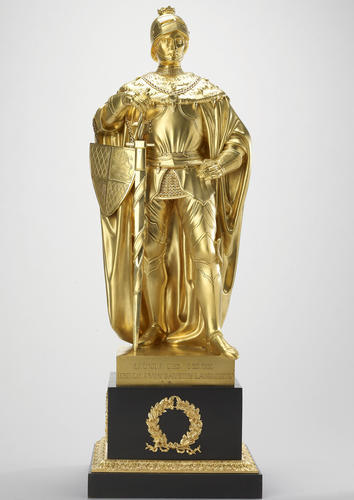
After Ludwig Michael von Schwanthaler (1802-48)
Master: Twelve historical rulers of Bavaria Item: Ludwig der Reiche, Herzog von Bayern Landshut c. 1842
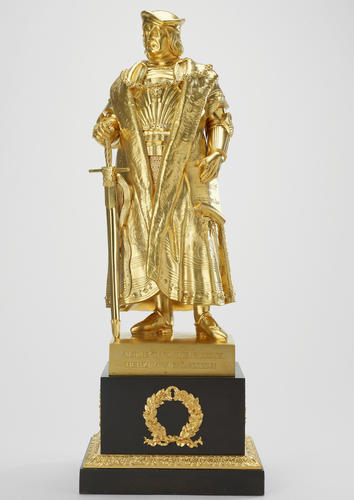
After Ludwig Michael von Schwanthaler (1802-48)
Master: Twelve historical rulers of Bavaria Item: Albrecht IV der Weise, Herzog von Bayern c. 1842
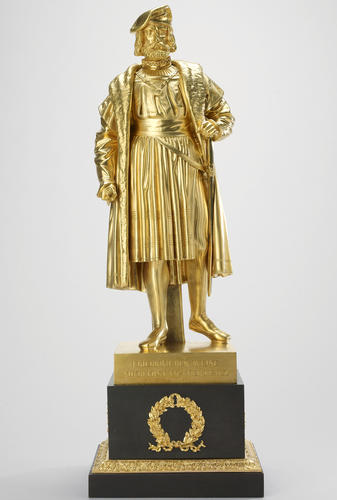
After Ludwig Michael von Schwanthaler (1802-48)
Master: Twelve historical rulers of Bavaria Item: Friedrich der Weise, Churfürst von der Pfalz c. 1842
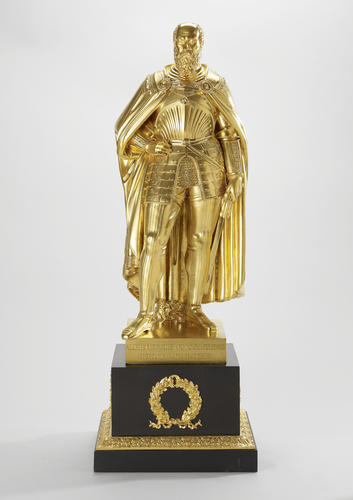
After Ludwig Michael von Schwanthaler (1802-48)
Master: Twelve historical rulers of Bavaria Item: Albrecht V der Grossmüthige, Herzog von Bayern c. 1842
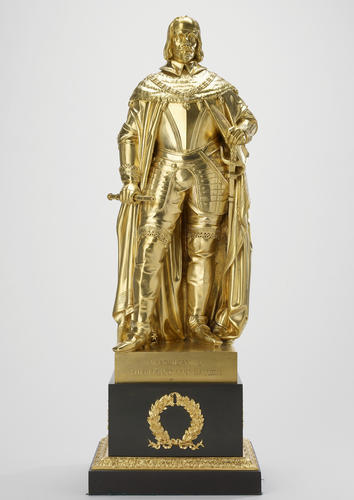
After Ludwig Michael von Schwanthaler (1802-48)
Master: Twelve historical rulers of Bavaria Item: Maximilian I, Churfürst von Bayern c. 1842
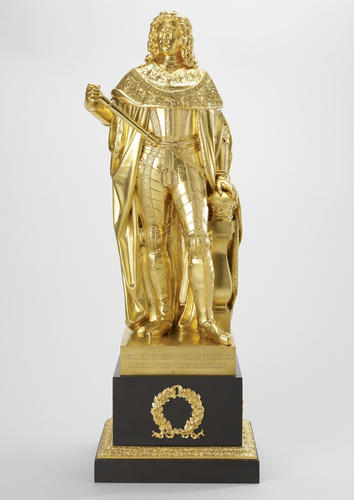
After Ludwig Michael von Schwanthaler (1802-48)
Master: Twelve historical rulers of Bavaria Item: Carl XI, Koenig von Schweden, Herzog von Zweybrücken c. 1842

After Ludwig Michael von Schwanthaler (1802-48)
Master: Twelve historical rulers of Bavaria Item: Johann Wilhelm, Churfürst von der Pfalz c. 1842
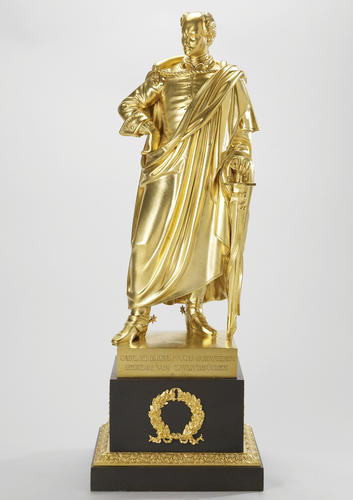
After Ludwig Michael von Schwanthaler (1802-48)
Master: Twelve historical rulers of Bavaria Item: Carl XII, Koenig von Schweden, Herzog von Zweybrücken c. 1842












-
A set of twelve gilt bronze imaginary statuettes representing the Dukes of Bavaria, Electors of the Palatinate and Kings of Sweden from 1253-1718. All on square stepped gilt and patinated bronze bases inscribed with the names of the subjects and with applied gilt bronze laurel wreath mounts at the front. The statuettes depict: Otho, Duke of Bavaria (d. 1253), Ludwig, Duke of Bavaria (d. 1347), Rupert, Elector Palatine (d. 1410), Frederick the Victorious, Elector Palatine (d. 1476), Ludwig the Rich, Duke of Bavaria (d. 1479), Albert IV the Wise, Duke of Bavaria (d. 1508), Frederick the Wise, Elector Palatine (d. 1556), Albert V the Magnanimous, Duke of Bavaria (d. 1579), Maximilian I, Elector of Bavaria (d. 1657), Charles IX, King of Sweden (d. 1697), Johann Wilhelms, Eelector Palatine (d. 1716) and Charles XII, King of Sweden (d. 1718).
Queen Victoria's enthusiastic reaction to the arrival of these figures is recorded in her journal: 'My beloved one had the immense kindness of giving me, what I had so long wished for 12 statuettes, copied in small from Schwanthaler's gilt statues in the Throne Room at Munich. They are so beautiful, in gilt bronze' (24 May 1843). They were placed immediately on the fitted gilt-bronze-mounted rosewood bookcases in the Green Drawing Room at Windsor, taking their place between patinated bronze statuettes and groups, chiefly on the French baroque, and gilt-bronze candelabra by Caffiéri and Thomire.
The statuettes are reductions of a series of statues, each around 10ft high, commissioned from Schwanthaler by King Ludwig I of Bavaria to stand between the columns of the new Throne Room in the Munich Residenz, completed in 1825 from designs by Leo von Klenze (1784-1864).
Both the colossal figures (completed in 1842 but largely destroyed during the Second World War) and the reductions were cast in the royal foundry at Munich, established by the King in 1824 under J.B. Stiglmaier. As the Valhalla at Regensburg, also by Klenze, the series exemplified the King's ambition to establish Munich as a capital of the arts and to engender national pride. In much the same spirit, Schwanthaler and Stiglmaier collaborated on a set of twenty-four statues of great painters for the Neue Pinakothek.
For the historical likenesses, Schwanthaler resorted to coins, engravings and in some cases contemporary relief portraits, but much was invented to give the series a picturesque variety. Reductions began to be made before the colossal series was finished. A complete set was ordered by Tsar Nicholas I in 1839 and another was made as a diplomatic gift for the King of Prussia in 1842.
Text from: Victoria & Albert: Art and Love: Royal Collection Exhibition Catalogue, 2010, Catalogue Entry 80Provenance
Given to Queen Victoria by Prince Albert, on her bithday, 24th May 1843. [Victoria & Albert: Art & Love, London, 2010, pg 456]
Copied from original models for the Throne Room of the Palace of Munich by Schwanthaler. -
Creator(s)
(founder (metals))Acquirer(s)
-
Medium and techniques
Gilt bronze, bronze
Measurements
69.7 x 23.6 x 23.0 cm (general measurement for all members)
Category
Object type(s)